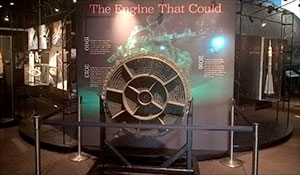 advertisements advertisements
|

|
Photos: Recovered NASA engines land at Seattle's Museum of Flight
November 20, 2015 — At a press conference held on Thursday (Nov. 19) — on the anniversary of the second manned moon landing in 1969 — The Museum of Flight in Seattle made the first public showing of the recovered remains of the F-1 rocket engines used to launch NASA's historic Apollo 12 and Apollo 16 missions.
The F-1 engine components were recovered from the sea by Seattle-based Bezos Expeditions in 2013 and have been under conservation at the Cosmosphere in Kansas. At the request of Amazon.com CEO Jeff Bezos, NASA has now given the artifacts to The Museum of Flight for permanent display. One Apollo 12 artifact will be on temporary public display beginning Saturday (Nov. 21). The full collection is planned to debut on exhibit in 2017.
See the preserved F-1 engine parts now at The Museum of Flight below and read more here: Amazon CEO delivers historic NASA moon engines to Seattle museum |
|

Photos: Cosmosphere / Museum of Flight / NASA |

The Rocketdyne F-1 engine stood 12.2 feet wide and 18.5 feet tall (3.7 by 5.6 meters). Parts from engines that launched Apollo 12 in 1969 and Apollo 16 in 1962 were donated to The Museum of Flight in Seattle. (The Museum of Flight) |

Each Saturn V launched on five F-1 engines. Seen here, the Saturn V first stage (S-IC) that launched Apollo 12. The engine parts donated to The Museum of Flight came from the no. 3 engine (bottom left). (NASA) |

Apollo 12 launched at 11:22 a.m. EST on Nov. 14, 1969 from Launch Complex 39A at the Kennedy Space Center in Florida. The Saturn V first stage F-1 engines burned for the first 150 seconds of flight before being jettisoned and plunging back to an ocean splashdown. (NASA) |

The recovered thrust chamber from the no. 3 F-1 engine that launched Apollo 12. The thrust chamber provided a combustion chamber for burning propellants under pressure. As see above, the nozzle would extend to the right. (Cosmosphere) |

Apollo 12 no. 3 F-1 engine thrust chamber. (Cosmosphere) |
 
Apollo 12 no. 3 F-1 engine thrust chamber. (The Museum of Flight) |

Fuel flowing through the chamber tubes provided regenerative cooling of the chamber walls during engine operation. (The Museum of Flight) |

The oxidizer, or liquid oxygen (LOX) dome, from the Apollo 12 no. 3 F-1 engine. The dome served as a manifold for distributing oxidizer to the thrust chamber injector, provided a mounting surface for the gimbal bearing and transmitted the engine's thrust forces to the vehicle structure. (The Museum of Flight) |

The LOX dome from the Apollo 12 no. 3 F-1 engine. (Cosmosphere) |

The LOX dome from the Apollo 12 no. 3 F-1 engine. (Cosmosphere) |

The injector plate from the Apollo 12 no. 3 F-1 engine. The injector plate directed fuel and oxidizer into the thrust chamber in a pattern that ensured efficient and satisfactory combustion. (Cosmosphere) |

The injector plate from the Apollo 12 no. 3 F-1 engine. (Cosmosphere) |
 
Amazon.com CEO Jeff Bezos presents the injector from the Apollo 12 F-1 engine at The Museum of Flight on Nov. 19. (The Museum of Flight) |

The Museum of Flight is exhibiting the injector plate from Nov. 21 through Jan. 4, 2016. It will then be moved into the archives until 2017, when it will return with the rest of the F-1 artifacts as part of a new permanent Apollo exhibit. (The Museum of Flight) |

Apollo 16 launched at 12:54 p.m. EST on April 16, 1972 from Launch Complex 39A at the Kennedy Space Center in Florida. (NASA) |

Gas generator from F-1 engine that launched Apollo 16. The generator provided the hot gases for driving the turbine, which in turn drove the fuel and oxidizer pumps. (The Museum of Flight) |

Gas generator from F-1 engine that launched Apollo 16. (The Museum of Flight) |

Turbine from Apollo 16 engine. The turbine, which produced 55,000 horsepower, drove the fuel and oxidizer pumps. (The Museum of Flight) |

Turbine blades from an Apollo 16 F-1 engine. (The Museum of Flight) |
|

© 1999-2025 collectSPACE. All rights reserved.
|
|

|

|
